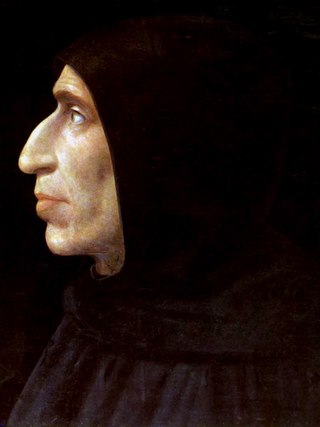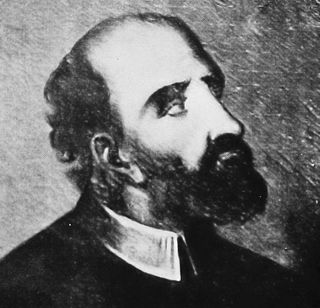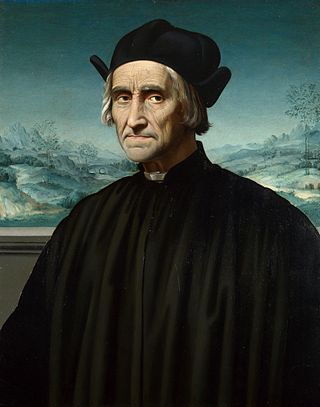The Reformation, also known as the Protestant Reformation and the European Reformation, was a major theological movement or period or series of events in Western Christianity in 16th-century Northwestern Europe that posed a religious and political challenge to the papacy and the authority of the Catholic Church. Towards the end of the Renaissance, the Reformation marked the beginning of Protestantism and in turn resulted in a major schism within Western Christianity.

Pope Leo X was head of the Catholic Church and ruler of the Papal States from 9 March 1513 to his death, in December 1521.

Girolamo Savonarola, OP, also referred to as Jerome Savonarola, was an ascetic Dominican friar from Ferrara and a preacher active in Renaissance Florence. He became known for his prophecies of civic glory, his advocacy of the destruction of secular art and culture, and his calls for Christian renewal. He denounced clerical corruption, despotic rule, and the exploitation of the poor.

Giovanni Pico dei conti della Mirandola e della Concordia, known as Pico della Mirandola, was an Italian Renaissance nobleman and philosopher. He is famed for the events of 1486, when, at the age of 23, he proposed to defend 900 theses on religion, philosophy, natural philosophy, and magic against all comers, for which he wrote the Oration on the Dignity of Man, which has been called the "Manifesto of the Renaissance", and a key text of Renaissance humanism and of what has been called the "Hermetic Reformation". He was the founder of the tradition of Christian Kabbalah, a key tenet of early modern Western esotericism. The 900 Theses was the first printed book to be universally banned by the Church. Pico is sometimes seen as a proto-Protestant, because his 900 theses anticipated many Protestant views.

The Counter-Reformation, also sometimes called the Catholic Revival, was the period of Catholic resurgence that was initiated in response to, and as an alternative to, the Protestant Reformations at the time. It is frequently dated to have begun with the Council of Trent (1545–1563) and to end with the conclusion of the European wars of religion in 1648, though this is controversial. The broader term Catholic Reformation also encompasses reforms and movements within the Church in the periods immediately before Protestantism or Trent and lasting later.

Philip Romolo Neri, sometimes referred to as the Second Apostle of Rome after Saint Peter, was an Italian Catholic priest who founded the Congregation of the Oratory, a society of secular clergy dedicated to pastoral care and charitable work. Neri's spiritual mission emphasized personal holiness and direct service to others, particularly through the education of young people and care for the poor and sick. His work played a significant role in the Counter-Reformation, especially within the city of Rome.

A bonfire of the vanities is a burning of objects condemned by religious authorities as occasions of sin. The phrase itself usually refers to the bonfire of 7 February 1497, when supporters of the Dominican friar Girolamo Savonarola collected and burned thousands of objects such as cosmetics, art, and books in the public square of Florence, Italy, on the occasion of Shrove Tuesday, martedí grasso.

Philippe Verdelot was a French composer of the Renaissance, who spent most of his life in Italy. He is commonly considered to be the father of the Italian madrigal, and certainly was one of its earliest and most prolific composers; in addition he was prominent in the musical life of Florence during the period after the recapture of the city by the Medici from the followers of Girolamo Savonarola.

Giovanni Animuccia was an Italian composer of the Renaissance who was involved in the heart of Rome's liturgical musical life. He was one of Giovanni Pierluigi da Palestrina's most important predecessors and possibly his mentor. As maestro di capella of St Philip Neri's Oratory and the Capella Giulia at St Peter's, he was composing music at the very center of the Roman Catholic Church, during the turbulent reforms of the Counter-Reformation and as part of the new movements that began to flourish around the middle of the century. His music reflects these changes.
Protestant Reformers were theologians whose careers, works and actions brought about the Protestant Reformation of the 16th century.
Lupus Hellinck was a Flemish composer of the Renaissance. He was a prominent composer of masses, as well as German chorales and motets. Although he was a Roman Catholic all of his life, his music shows evidence of sympathy for the Protestant Reformation, and three of his motets—including a famous setting of In te domine speravi—were probably inspired by the prison writings of the martyred reformer Girolamo Savonarola.

Infelix ego is a Latin meditation on the Miserere, Psalm 51, composed in prison by Girolamo Savonarola by 8 May 1498, after he was tortured on the rack, and two weeks before he was burned at the stake in the Piazza della Signoria in Florence on 23 May 1498. The prison authorities had spared only his right arm during the preliminary torture, so that Savonarola would be able to sign his confession: after doing so, and in a state of despair at not being strong enough to resist the pain of his prolonged torture, he wrote Infelix ego and a portion of a companion meditation, Tristitia obsedit me, on Psalm 30. He was executed before he was able to complete Tristitia obsedit me.

Pietro Bernardino dei Fanciulli was a follower of Savonarola.

Girolamo Benivieni was a Florentine poet and a musician. His father was a notary in Florence. He suffered poor health most of his life, which prevented him from taking a more stable job. He was a leading member of the Medicean Academy, a society devoted to literary study. He was a friend of Giovanni Pico della Mirandola (1463–1494), whom he met for the first time in 1479; it was Pico della Mirandola who encouraged him to study Neoplatonism. In the late 1480s, he and Pico della Mirandola became students of Dominican friar Girolamo Savonarola (1452–1498). In 1496, he translated the teachings of Savonarola from Italian to Latin. After he began following Savonarola, he rejected his earlier poetry and attempted to write more spiritually. He participated in Savonarola's Bonfire of the Vanities, and documented the destruction of art worth "several thousand ducats".
The Miserere, by Josquin des Prez, is a motet setting of Psalm 51 for five voices. He composed it while in the employ of Duke Ercole I d'Este in Ferrara, in 1503 or 1504. It was one of the most famous settings of that psalm of the entire Renaissance, was hugely influential in subsequent settings of the Penitential Psalms, and was itself probably inspired by the recent suffering and execution of the reformer Girolamo Savonarola.
The Protestant Reformation began in 1520s in the Italian states, although forms of pre-Protestantism were already present before the 16th century. The Reformation in Italy collapsed quickly at the beginning of the 17th century. Its development was hindered by the Inquisition and also popular disdain.

Donald Weinstein was a leading American historian of the Italian Renaissance.

Proto-Protestantism, also called pre-Protestantism, refers to individuals and movements that propagated various ideas later associated with Protestantism before 1517, which historians usually regard as the starting year for the Reformation era. The relationship between medieval sects and Protestantism is an issue that has been debated by historians.

The Portrait of Girolamo Savonarola is an oil-on-panel painting by the Italian Renaissance artist Fra Bartolomeo, created c. 1498. This portrait is believed to have been made when reformer Girolamo Savonarola was still alive and when Fra Bartolomeo was a follower of his renewal religious movement in Florence. It is held at the Museo di San Marco, in Florence.

Ugolino di Vieri, also known as Verino, was an Italian notary and poet in the Republic of Florence, best remembered for his Latin dactylic hexameter. Born in Florence to a noble family of magistrates, he was trained under Cristoforo Landino, and served as a court poet to Lorenzo de' Medici. He was a humanist and humanities teacher to Pope Leo X, Francesco Pitti, and Crinitus. He was also given patronage by Girolamo Savonarola and the Piagnoni. He died in Florence.
















